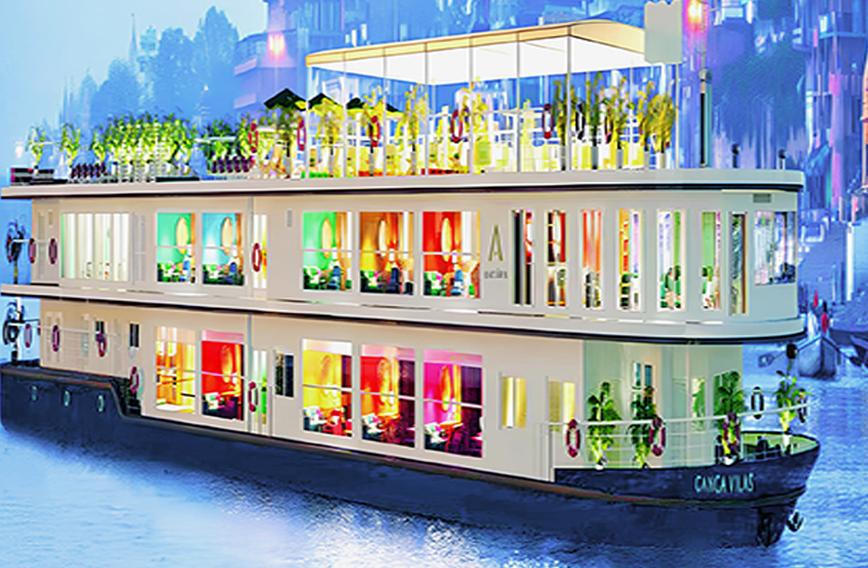
VENKATESH DUTTA
THE world’s longest river cruise, Ganga Vilas, that was flagged off in 2023, covers five states in India and Bangladesh and spans 27 river systems which are part of the Ganga basin. The luxurious cruise, like a floating hotel, is expensive — costing Rs 50-55 lakh per person. Obviously, it is beyond the reach of an average Indian. Some smaller cruises between Varanasi and Kolkata began in 2009. Before the advent of the railways, this waterway served as India’s principal transport artery. In the late 18th century, an estimated 30,000 boats plied the waters between Dhaka and Benaras, transporting merchandise along this vital trade route.
Rivers have been a lifeline not only for trade and commerce, but also for cultural exchange — contributing to bustling riverine activity. Many heritage and sacred sites are along riverbanks, and with efficient navigation both traders and pilgrims from various parts of India used to travel along the rivers.
The navigation on the Ganga and its tributaries dates back thousands of years. The river was a vital artery for trade and transportation in ancient times. Civilizations such as the Indus Valley Civilization and the Vedic civilization flourished along its banks. Historical texts and archaeological findings suggest that boats were used for transportation and trade along the river as early as 2000 BCE.
During the ancient period, especially under the rule of the Maurya and Gupta Empires, river trade flourished along the major Ganga towns. Merchants used the river to transport spices, textiles, timber and other commodities between cities and regions. Several important trade routes developed along the river, connecting the Gangetic plains with the rest of India.
In 1602, Dutch merchants established the Dutch East India Company, marking the beginning of Dutch factories and ships in the lower delta. By the mid-17th century, the Dutch had emerged as the primary exporters of various textiles to Europe and Japan, and they established factories along the Ganga in Bengal and Bihar. In his memoir, Babur mentions several instances of travelling on or crossing rivers, including the Ganga, during his military campaigns and journeys across the country. Akbar brought his army to Bengal by boat during the mid-16th century. The Mughal rulers further enhanced navigation on the Ganga between the 16th and 18th centuries. They invested in improving waterways and infrastructure along its banks. They constructed several ghats and established river ports to facilitate trade and commerce.
During British rule, between the 18th and 20th centuries, the Ganga continued to be a vital artery for transportation and trade in northern India. Major James Rennell, a British geographer, played a key role in mapping India’s waterways during the 18th century. He became the first Surveyor General of Bengal in 1764, a position he held for more than a decade. Rennell’s maps not only depicted the course of the Ganga and its tributaries but also provided valuable information about the surrounding topography, geography, and settlements. The British constructed several canals, barrages, and navigation locks to improve navigation along the river and its tributaries. The Ganga became an integral part of British India’s economy, facilitating transportation of goods and raw materials between different parts of India.
The mid-19th century is often considered a significant period for navigation on the Ganga in India, referred to as the ‘Golden Age’ of river navigation (see Slowly Down the Ganges by Eric Newby). The introduction of steam-powered boats revolutionized river transportation. Steamboats were faster and more reliable than traditional sailboats or oar-powered vessels, allowing for quicker and more efficient movement of goods and passengers along the Ganga. Private steamboat companies with passengers were sailing on the Ganga from Howrah to Garhmukteshwar, touching major towns of Patna, Allahabad, Varanasi and Kanpur.
Prospects of navigation on the Ganga with movement of bulk cargo, containers, and passengers are being explored once again, though it has faced several challenges due to lack of sufficient water and navigable depth. A moving boat needs enough water so that it does not hit the riverbed. Today, there is reduced flow downstream of Haridwar. The Upper Ganga Canal diverts most of the water from the river, with very little water flowing downstream. Many bridges and rail tracks criss-cross the river, making the movement of large ships difficult. The Bhimgoda Barrage in Haridwar, the Middle Ganga Barrage in Bijnor, and the Lower Ganga Barrage in Narora collectively divert nearly 85 percent of the river’s flow during the lean season. This extensive abstraction significantly diminishes the volume of water in the river until it receives replenishment from the Ramganga, Gomti and Yamuna tributaries.
The minimum navigable water depth should be from 1.5 to 2.5 metres. Along several stretches of the river, this depth is not maintained especially during the lean season. Obviously, one would want to make a deep channel within the river by dredging out something akin to a canal over which boats can safely travel. However, dredging a river which has a high sediment load and which often changes its course is not easy. It also disturbs the riverine ecosystems.
The National Waterway-1 (NW-1), which is also known as the Ganga-Bhagirathi-Hooghly River System, is being developed to facilitate commercial navigation and trade along the Ganga and its tributaries. It would cover a distance of about 1,620 km, from Haldia to Allahabad, making it the longest national waterway in India. But with diminishing flow and over-extraction through canals, navigation could be caught in troubled waters.
Venkatesh Dutta is a Gomti River Waterkeeper and a professor of environmental sciences at Ambedkar University, Lucknow
Comments
Currently there are no Comments. Be first to write a comment!




